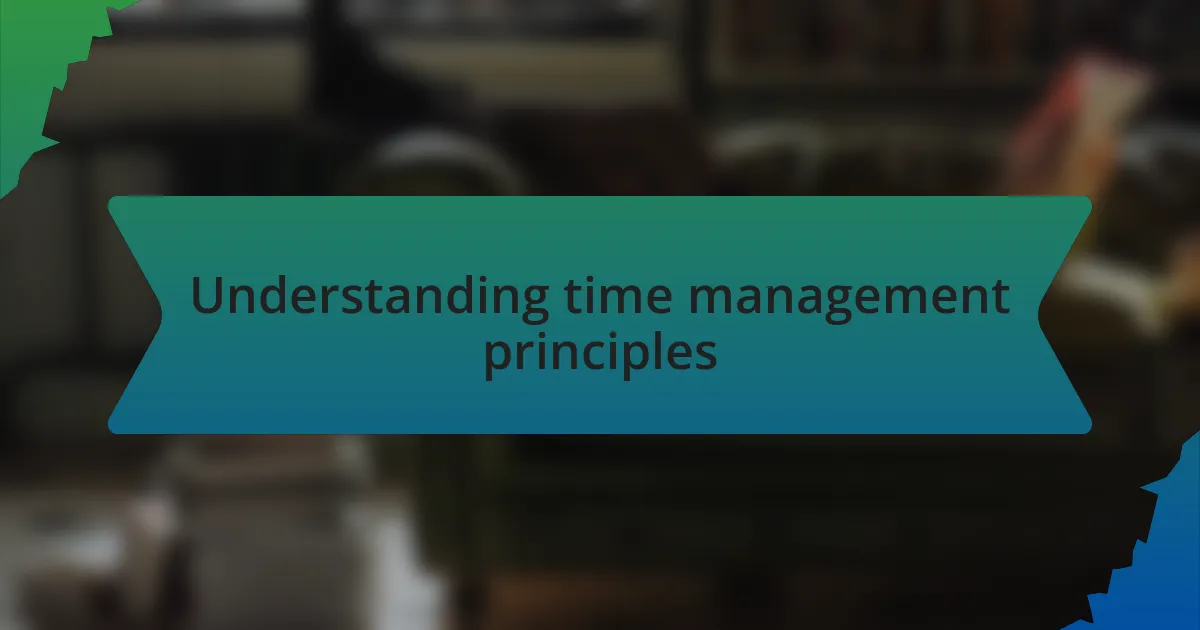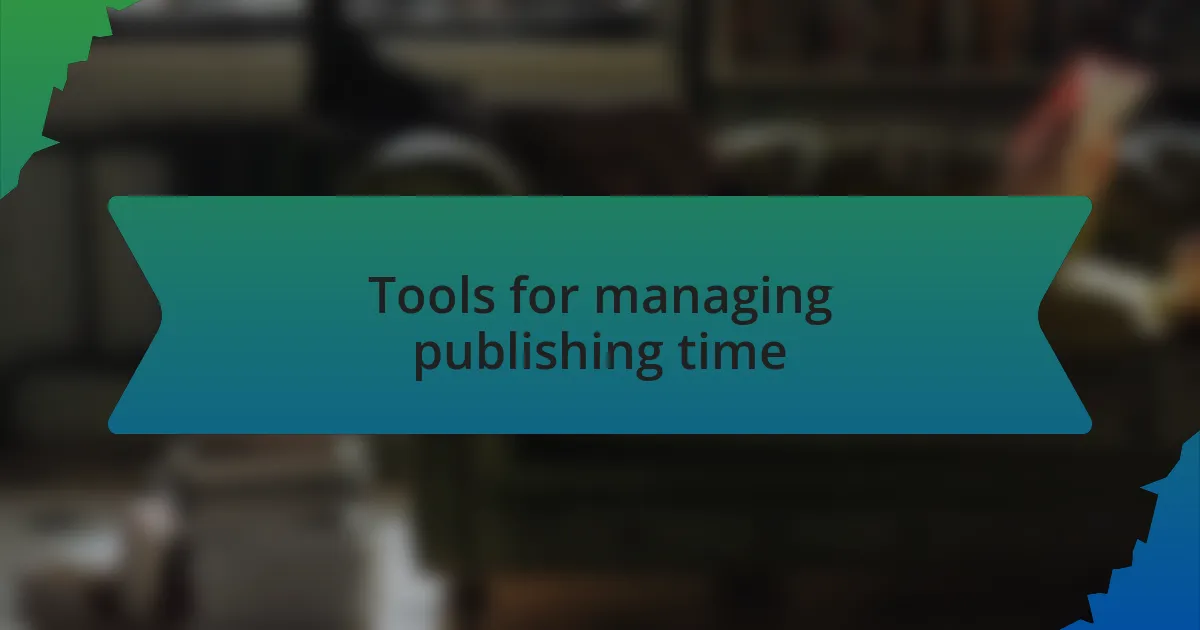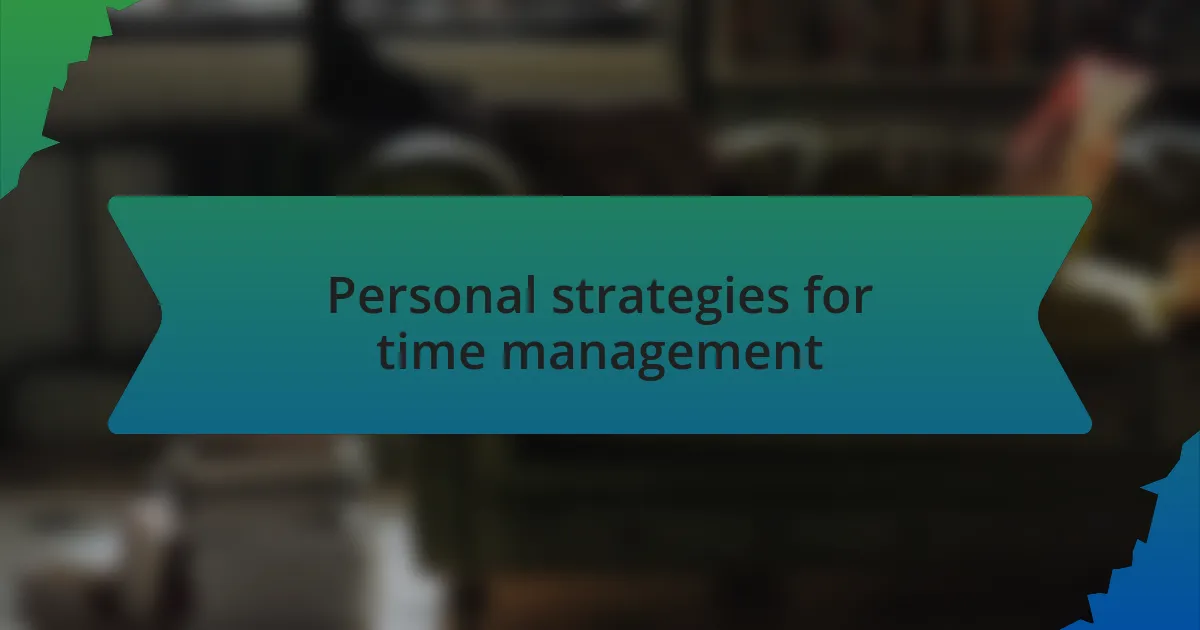Key takeaways:
- Prioritization and the Eisenhower Matrix help distinguish between urgent and important tasks, enhancing focus and productivity.
- Establishing boundaries and protecting time from distractions fosters creativity and deep work.
- Implementing techniques like the Pomodoro Technique and time blocking can create structure and improve task management.
- Flexibility in scheduling and regularly reassessing priorities allows for adaptation to unexpected tasks and aligns efforts with long-term goals.

Understanding time management principles
Understanding the principles of time management can profoundly shape how we approach both our personal and professional lives. I remember when I first started my journey in independent publishing; the sheer volume of tasks felt overwhelming. It made me realize that mastering time management was not just an option but a necessity. Have you ever felt that rush of anxiety, staring at a to-do list that seems impossible?
One principle that stands out to me is prioritization. It’s about tackling the most critical tasks first, and I often find that using the Eisenhower Matrix helps me distinguish between urgent and important tasks. By categorizing my activities, I’ve learned to focus on what truly moves my projects forward, rather than getting bogged down in minor details. This approach has not only increased my productivity but has also alleviated that nagging feeling of being constantly busy without making meaningful progress.
Another essential concept is setting boundaries. In my experience, saying no to distractions is one of the most powerful tools at my disposal. It was challenging at first, especially when friends or colleagues asked for my time. But I’ve found that by protecting my time fiercely, I create a sacred space for creativity and deep work. Have you considered how much your productivity might benefit from this kind of intentional boundary-setting?

Common time management techniques
One common technique I find invaluable is the Pomodoro Technique, which involves working for a set period—typically 25 minutes—and then taking a short break. When I first tried this method, I was amazed at how focused I could become in just a few minutes of concentrated effort. It’s almost like resetting my brain after each session, allowing me to tackle the next task with renewed energy. Have you ever noticed how a brief pause can refresh your perspective?
Another approach that has worked for me is time blocking. This method is all about assigning specific slots in my calendar for different activities. Initially, I used to underestimate how impactful this could be. Now, I schedule not just my deadlines but also chunks of time for deep work, meetings, and even breaks. It creates a structure that keeps my day from spiraling out of control. Does having a clear roadmap of my day make me feel more in control? Absolutely.
Finally, I can’t overlook the importance of a daily review. Each evening, I take a moment to reflect on what I’ve accomplished and what needs to shift for tomorrow. This simple act of self-assessment has been a game-changer for me, offering clarity on my progress and areas of improvement. Have you tried reflecting on your day? You might find it opens up new pathways to efficiency and satisfaction in your work.

How to prioritize tasks effectively
Prioritizing tasks effectively starts with understanding what’s urgent and what’s important. I remember a time when I was overwhelmed with simultaneous deadlines for various projects. By categorizing my tasks using the Eisenhower Matrix, which differentiates between urgent and important tasks, I realized that some activities could wait while others required immediate attention. This clear distinction transformed my approach, allowing me to focus on what truly mattered.
Another strategy I’ve found valuable is creating a top-three task list each morning. At first, I juggled too many responsibilities at once, feeling the weight of my to-do list crash down on me. However, identifying just three key tasks to tackle each day has been liberating. It’s like a mental flashlight guiding me through the fog of my workload—focusing my energy where it counts. Have you tried narrowing your focus this way?
Lastly, I’ve adopted the habit of regularly reassessing my priorities throughout the week. I once thought that once I set my priorities, they were set in stone. But life is unpredictable, and sometimes new tasks demand attention. By allowing myself the flexibility to adjust, I’ve learned that it’s not just about sticking to a schedule; it’s about aligning my actions with my goals. Reflecting on this adjustment process often leaves me feeling more adaptable and proactive toward my workload. How do you adapt your priorities when unexpected tasks arise?

Tools for managing publishing time
Managing time effectively in publishing requires the right tools. One tool that has been a game changer for me is Trello. When I first started using it, I was struggling to keep track of different projects and their statuses. The visual layouts and card features allowed me to organize my tasks effectively, enabling me to move cards through various stages of completion. Have you ever found yourself lost in a sea of projects? This tool helped me visualize my workload, making it easier to prioritize and stay on course.
Another resource that has significantly improved my productivity is Google Calendar. I can still remember the days when I doubted if scheduling my writing time would help. But once I committed to blocking out specific times for writing, my output soared. Setting reminders and creating daily routines has made a world of difference. It’s not just about knowing what tasks I have; it’s about creating space for creativity to flourish. How do you keep track of your important deadlines?
Lastly, I’ve embraced the Pomodoro Technique, which involves working in focused bursts followed by short breaks. Initially, I was skeptical about the effectiveness of timing my work sessions, but I was pleasantly surprised. After utilizing this method, I noticed a healthy balance between focus and rest. It’s astonishing how stepping away for just five minutes can recharge my mental energy. Have you experimented with structured working intervals? This approach has enriched my writing routine and propelled me through numerous publishing projects.

Personal strategies for time management
Finding your personal rhythm in time management is crucial, especially in the realm of independent publishing. One strategy that I’ve found particularly effective is establishing a “power hour.” This is a dedicated time when I focus solely on my writing, free from distractions. There was a period when I felt overwhelmed with my workload, but setting this hour transformed my approach. Have you ever noticed how your productivity spikes when you’re entirely in the zone? It’s like flipping a switch; suddenly, ideas flow and words pour out effortlessly.
Another strategy I use is the practice of weekly reviews. Every Sunday, I take a moment to reflect on my accomplishments and set goals for the upcoming week. This ritual not only provides closure to my previous week but also ignites my motivation for what lies ahead. I vividly remember a time when I neglected this practice, and I found myself scrambling through tasks with no clear direction. Have you tried taking time to reflect on your progress? It’s enlightening to see how far you’ve come and what you still wish to achieve.
Lastly, I’ve learned to cultivate the habit of saying no. As tempting as it is to embrace every opportunity, I’ve come to understand that not every project aligns with my publishing vision. There was a time when I felt obligated to accept every collaboration that came my way, but this ultimately drained my energy and creativity. Have you experienced a similar struggle? I’ve found that focusing on my passion projects leads to greater fulfillment and productivity, allowing me to manage my time more effectively in the long run.

Lessons learned from my experiences
In my journey of mastering time management, one key lesson stands out: the importance of flexibility. Early on, I tightly scheduled my day, believing that a rigid plan would maximize productivity. However, I soon learned that unexpected events could derail even the best-laid plans. Have you ever felt crushed when something disrupts your schedule? Embracing the ebb and flow of life allowed me to adjust on the fly, which surprisingly enhanced my focus and creativity rather than stifling it.
Another significant realization came when I shifted my mindset around prioritization. Initially, I’d tackle tasks based on urgency alone, thinking that urgency equated to importance. This often led me to neglect projects that truly mattered to my goals. I vividly recall a moment when I spent hours on a last-minute request, only to realize later it didn’t contribute to my vision at all. How often do we fall into the trap of the “urgent over the important”? Understanding the distinction helped me align my efforts with my long-term objectives, making each working session feel purposeful.
Lastly, I discovered the value of community in enhancing my time management skills. At one point, I joined a writing group where we shared our challenges and successes. The encouragement and accountability were game-changers. Have you ever experienced the power of collaboration? It’s remarkable how discussing our struggles can uncover new strategies and strengthen our resolve. Having a support network not only motivates me but also helps me stay committed to my writing schedule, turning what once felt isolating into a shared journey of growth.